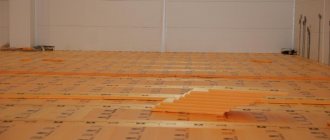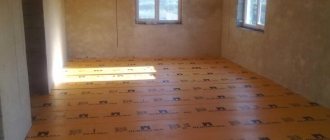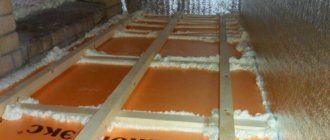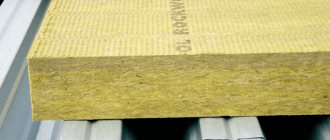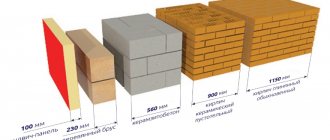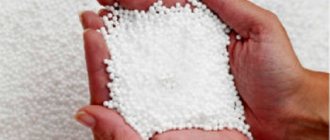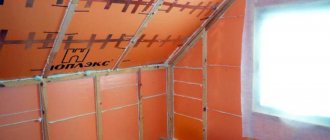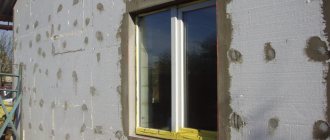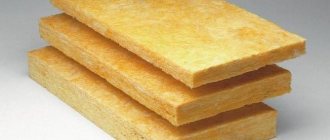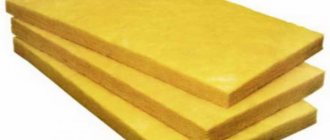We have already written about what Penoplex 30 mm lightweight insulation can do in an article on the website, now let’s talk about other types of products from the popular brand.
Are you planning to use Penoplex extruded polystyrene foam for thermal insulation of an object, but can’t figure out the brands and density of insulation? Especially for you, we have systematized useful information in this article so that you can easily understand the densities of Penoplex and give even an experienced builder a head start.
Old classification of Penoplex insulation
Initially, the plant produced three types of extruded polystyrene foam depending on density: Penoplex 35 (with a density of 35 kg/m3), Penoplex 45 (45 kg/m2) and Penoplex Standard (32 kg/m3). In addition to density indicators, insulation materials have different sizes, thickness, compressive strength, flammability group and KMO class. The scope of use of each insulation also varies.
- Penoplex 35 density is one of the most popular brands of insulation, which was used to insulate various types of enclosing structures: foundations and plinths, operated and unused roofs, floors and walls.
- Penoplex 45 coped with increased loads when insulating foundations, ground floors, as well as highways and railways, runways, bridges, tunnels in the Far North and on heaving soils.
- Penoplex STANDARD was most often used to insulate swimming pool bowls, floors and shallow foundations, fire tanks, settling tanks and wells.
Previously, Penoplex extrusion was produced in standard thicknesses from 20 to 100 mm, width 600 mm and length 1200 mm. We sorted out the old parameters. It's time to find out the modern classification of Penoplex.
Density table for Penoplex 35, 45 and Standard insulation
| Density | Length, mm | Width, mm | Thickness, mm |
| 35 | 1200 | 600 | 20, 30, 40, 50, 60, 80, 100 |
| STANDARD | 1200 | 600 | 20, 30, 40, 50, 60, 80, 100 |
| 45 | 2400 | 600 | 40, 50, 60, 80, 100 |
General installation information
Penoplex is quite easy to work with, but there are a number of aspects that need to be taken into account during installation in order to do everything correctly. So, as for the method of fastening, the slabs need to be fixed using the method that is most suitable for a specific element of the structure. For example, if the base or foundation is insulated, that is, that part of the building that is located below the upper boundary of the soil, then the material can be glued and then pressed down with soil. If Penoplex is used to insulate floors, then it is best to simply put it under the screed - there is no need for any fixation. But on the walls, the material must first be glued, and then additionally fixed with special disc-shaped dowels with a wide head. Sometimes Penoplex is also attached to the sheathing.
Penoplex board insulation
For adhesive fixation, a special composition Penoplex FastFix is used. It is applied to the surface of the slabs evenly in stripes around the perimeter, retreating from the edge of the slab about 1-3 cm, as well as in the middle of the slab. It is recommended to make the slab slightly rough by making notches or treating it before applying the glue. This will improve grip. The glue consumption is as follows: one bottle is enough for about 100 meters of linear seams, that is, it can glue about 10 m2 of insulation.
Attention! When fixing Penoplex to the wall, glue alone is not enough - you will also have to use dowels.
As for dowels, it is better to take synthetic ones with low thermal conductivity to avoid the appearance of cold bridges. The holes for them need to be drilled so that they are approximately 1-1.5 cm longer than the length of the dowel being driven in. As for fixing the material on concrete, in this case the minimum length of the spacer part of the fastener should be at least 4.5 cm, and for brick even longer - 6-9 cm. For foam concrete, it is better to select longer dowels, at least 10-12 cm.
Fastening Penoplex with umbrella dowels
Prices for dowels for fastening insulation
Dowel umbrella
On a note! If Penoplex is fixed over a waterproofing material, then it is important to replace the dowels with special weld-on fasteners.
As for the thickness of the insulation, we remember that it can be different. This parameter must be determined taking into account the climatic characteristics of the region and the purpose of the building structure, as well as the materials from which it is constructed. The easiest way to find out the optimal thickness in each specific case is to use a special calculator on the Penoplex website. It will also help identify the required number of slabs.
Installation of Penoplex sheets
Classification of Penoplex in a modern version
Old brands are a thing of the past, and information on the Internet about the availability of these goods in warehouses is clearly irrelevant.
This is easy to determine if you contact the managers of such online stores. Attention! The manufacturer has every right to rebrand and change sizes and technical characteristics in order to improve the quality of its products.
We are official dealers of the Penoplex plant in the Moscow region, therefore we offer the latest information about the products supplied. From previous types of thermal insulation, Penoplex 45 insulation is still produced, which does not lose popularity among developers. You can purchase thermal insulation material of this brand of the required size and thickness from our company at an excellent price right now.
- Penoplex Roofing. Insulation with a density of 28-33 kg/m3 is an improved analogue of the good old Penoplex 35, the thickness of which varies from 20 to 150 mm, length 1185 and 2370 and thickness 585 mm. The slabs are indispensable for insulating all types of roofing systems.
- Penoplex pitched roof. The material was specially developed by engineers for effective thermal insulation of pitched roofs in private suburban construction. Available in thicknesses of 100, 120 and 150 mm.
Corresponds to the old type Penoplex 35 without fire retardant additives and is produced in thicknesses of 50 and 80 mm, length 1185 and width 585 mm. Recommended for insulating loaded structures and can be used for at least 50 years without deformation or loss of thermal insulation properties.
Penoplex Foundation.- Penoplex Comfort. A real gift for private owners, corresponding to the outdated Penoplex 31C type with a density of 25-32 kg/m3. The range of thicknesses is presented in sizes from 20 to 150 mm. The slabs are indispensable for thermal insulation of loggias and balconies, walls of apartments and country houses.
- Penoplex Geo. High-density slabs are designed for insulation of various recessed structures. The thickness of the slabs varies from 20 to 150 millimeters, and the increased length of up to 2370 mm makes it possible to reduce the number of joints and minimize cold bridges.
- Penoplex Base. Such insulation allows you to thoroughly protect the base, walls and pitched roof from freezing for decades to come. The dimensions of the material fully correspond to Penoplex Geo insulation, and the density of Penoplex Basis ranges from 28 to 35 kg/m3.
- Penoplex Facade. The material is an updated version of Penoplex 31 with fire retardants and, as its name implies, is intended for insulation of facade systems of private and multi-storey houses, industrial buildings, as well as heat and sound insulation of walls and partitions. The standard sizes of the slabs correspond to the two previous brands.
Note: the longest slabs from the entire Penoplex line include the industrial insulation PENOPLEX®BLOK, up to 3000 mm long, designed for thermal insulation of roads.
The range of modifications of Penoplex insulation has expanded significantly. Now you can quickly select the appropriate material, since the name of the series is consonant with the structures where it is applicable. Penoplex Roofing, Facade, Geo and others. We invite you to watch the video to understand how the foundation of a house is insulated with Penoplex Foundation slabs.
Advantages and disadvantages
Penoplex Comfort is a material for thermal insulation of buildings, which is suitable for the construction of premises for almost any purpose and is effective for providing thermal insulation of any surface.
Penoplex Comfort - technical characteristics
This is a fairly new material, which is made using the extrusion method from polystyrene and helps to solve a number of problems at once:
- allows you to achieve a high level of thermal insulation;
- protects all building structures from exposure to cold;
- helps reduce heating costs;
- provides a healthy and suitable indoor microclimate for humans.
The material has many advantages over conventional insulation materials, which is why it has earned popularity. First of all, it is worth noting its homogeneous porous structure, as well as its low weight, which makes it easy to work with the material and not burden the structure. Thanks to its homogeneity, the material does not crumble.
Main types of Penoplex
The remaining advantages of Penoplex are as follows:
- due to its low thermal conductivity coefficient, it retains heat well;
- the material does not absorb water, which means it is also suitable for insulating saunas or baths, and not just residential buildings;
- Parasites do not live on Penoplex, fungus does not develop;
- excellent tensile and compressive strength;
- the material does not burn, as it is treated with special compounds;
Table of technical characteristics of Penoplex
- Penoplex also allows you to increase the level of sound insulation, as it perfectly absorbs noise;
- The material is convenient to work with - it can be cut with a simple knife, no special tool is required;
- you can work with Penoplex at any temperature;
- long service life (up to 50 years) makes it possible not to worry about quick repairs and replacement of insulation. Penoplex retains all its properties for a long time. And a number of specific experiments report that it can last even 80 years.
The material has many advantages
On a note! Any insulation must perform its primary functions well, and also be safe for humans, environmentally friendly, strong, and durable. Penoplex meets all these requirements.
But since ideal materials do not exist, it is important to talk about the disadvantages of this type of insulation. So, if you leave it in the sun without covering it, that is, in direct rays, the material will begin to deteriorate. Also, despite the fact that it does not burn, the smoke it produces in the event of a fire can be significant. Moreover, even extinguished Penoplex will smoke for a long time. And if a solvent is spilled on it, the material will collapse. By the way, this is why not all adhesives can be used when installing Penoplex. And, most importantly, and for many of decisive importance, is the price. The cost of the material is quite high.
Wall insulation with Penoplex
Prices for Penoplex
Penoplex
Table of technical characteristics of modern Penoplex brands
| Name | Test method | Dimension | Slab indicator |
| Compressive strength at 10% linear deformation, not less | GOST EN 826-2011 | MPa (kgf/cm2; t/m2) | 0,2 (2,0; 20) |
| Water absorption in 24 hours, no more | GOST 15588-86 | % by volume | 0,5 |
| Fire resistance category | F3-123 | group | G3 |
| Thermal conductivity coefficient at (25±5) °C | GOST 7076-99 | W/(m×°K) | 0,030 |
| Calculated thermal conductivity coefficient under operating conditions “A” | SP 50.13330.2012 | W/(m×°K) | 0,031 |
| Calculated thermal conductivity coefficient under operating conditions “B” | SP 50.13330.2012 | W/(m×°K) | 0,032 |
| Sound insulation of partition (GKL-PENOPLEX® 50 mm-GKL), Rw | GOST 27296-87 | dB | 41 |
| Standard sizes | Width | mm | 585 |
| Length | mm | 1185; 2370 | |
| Thickness | mm | 20; 30; 40; 50; 60; 80; 100; 120; 150 | |
| Operating temperature range | THAT | °C | -100 … +75 |
Properties of expanded polystyrene
This thermal insulation material has been known in Europe for more than 50 years. Its popularity is explained by the presence of closed pores, where the use of freon is not expected, as well as low cost of production. You can purchase extruded polystyrene foam at any building materials store. Despite its low cost, it has high thermal insulation efficiency.
Polystyrene foam consists of air bubbles, frozen foam. This is where the name Expanded Polystyrene comes from.
The differences lie in a completely new production method and a more modern material base.
In polystyrene foam, up to 85% of the volume is air, hence the thermal insulation properties. The denser the material, the lower the thermal insulation. Balls with a polystyrene shell (frozen polystyrene foam) successfully combine two properties - low thermal conductivity and high density.
The original foam is not permeable to steam, but it can absorb moisture up to 4%. Expanded polystyrene practically does not absorb water due to its density. But the improved waterproofing properties do not prevent this material from breathing. This happens due to the molding method; extruded polystyrene foam Penoplex is molded by cutting. The strength of this insulation is much higher due to the production method using extruders. The molecular bonds in this material are several times higher than in simple foam.
The fire safety of Penoplex is due to the addition of fire retardants to it. These are special substances that prevent the material from catching fire. Like any polymer, foam will burn if it can be set on fire. This is prevented by high resistance to sunburn. Its biological stability is also high. Molds cannot live on polymers.
We can briefly conclude that all the improved properties of expanded polystyrene are due to its more dense and uniform structure, as well as the use of raw materials with improved properties.
It is necessary to take into account a number of properties that polystyrene foam cannot provide:
- Low noise absorption ability. The rigid cells of insulated air act as resonators rather than sound dampers.
- Expanded polystyrene is not resistant to aggressive environments. He is afraid of acetone, varnishes, drying oil and turpentine. But it does not react with bitumen, soap and mineral fertilizers.
- In the heat, the foam oxidizes. While it is impossible to carry out complete polymerization of the components in production, harmful substances will be released when exposed to high temperatures.
Myths about Penoplex that are worth learning about!
The higher the density of penoplex, the warmer the house will be. It is enough to turn to primary school physics to understand: light slabs of low density will retain heat better, but their strength characteristics will be significantly lower.
Myth 1.- Myth 2. Extruded polystyrene foam Penoplex with a density of 100 kg/m3 exists. In fact, all attempts by consumers who want to find such material are in vain. The maximum value of slabs of this brand does not exceed 45 kg/m3.
- Myth 3. Extruded polystyrene foam insulation has been banned for use in the USA and European countries due to its toxicity. In fact, since 1995, foaming technology using freons has been banned. Foaming of Penoplex is carried out using carbon dioxide, which means the material is 100% environmentally friendly.
Are you ready to order thermal insulation boards made from extruded polystyrene foam Penoplex 35 of the required thickness? Or maybe you want to get a free insulation consultation on choosing density and sizes? Call us at +7 (495) 565-39-92 right now!
Production of expanded polystyrene
The French were the first to start producing it. The industrial production of expanded polystyrene was mastered in the late 30s of the twentieth century, only 10 years after the first production. In the early 60s of the last century it began to be used in construction
Possessing a whole range of qualities useful for construction, extruded polystyrene foam has attracted the attention of manufacturers of the Penoplex material
Penoplex acquires its properties during the production process. When receiving EPS, polystyrene foam is converted into a liquid state under the influence of heat and extruded using screw machines into a mold. Under the influence of temperature, the gas in the granules expands many times and the granules sinter together, filling the entire provided volume. Then the mold and material are cooled, the mold is halved and the resulting product is ready for packaging.
What is
Purely externally, penoplex resembles ordinary polystyrene foam, well known to many. However, such slabs have a higher density, are more expensive and can serve as insulation for much longer. Penoplex is much more resistant to ultraviolet radiation and other adverse environmental factors.
Modern industry produces many varieties of penoplex, differing in technical characteristics. One of the most popular types of this material are 50 mm sheets. Penoplex of this thickness has standard dimensions, weighs little, and therefore is very convenient to use, transport and store. The scope of its application is very wide.
Kinds
Roof
The side edges are L-shaped, provided with tongues and grooves. The series is produced with low thermal conductivity. It isolates noise from the street and sound from adjacent rooms. The slab is characterized by high strength. Roof insulation does not require high density due to the absence of load. The connection method is a tight connection without any bridges to the cold, guaranteeing reliable protection for the penetration of moisture inside.
Foundation
The series has a high density that is resistant to loads. The absence of a fire retardant in the board does not allow them to be used for other types of work. The use of material in the form of formwork saves money on pouring the foundation.
This type is in demand when building a house with heated floors on the ground. It is practical for sandy areas. The construction of the house is carried out on high-density slabs.
Laying out under the road surface
Insulation work protects the coating from swelling in winter. Compliance with the technology of the work carried out allows you to extend the operational characteristics of the route. High-density boards are used.
Comfort
An environmentally friendly product that does not emit toxic fumes, it is widely used in civil engineering.
Sloping series
For this type of work, low-density insulation with grooves and tenons along the contour is used. Double-sided protection of the roof frame will eliminate the entry of vapors from the side of the room and the formation of condensation on the joists. The external contour serves as waterproofing against atmospheric aggression.
The basis
The series is recommended for walls inside and outside, followed by finishing with plaster or wallpaper. The material is effective for insulating ceilings and floors. The hard surface does not require additional leveling when laying tiles or parquet. It is recommended to be used when installing heated floors.
Facade
By choosing a textured look, you get a ready-made base for painting. It is recommended to apply two layers of primer to ensure reliable adhesion before starting work. The slabs are fastened with a plaster-adhesive composition. This saves time on leveling masonry made of brick, foam blocks and cinder concrete. The fire retardant included in the composition protects the base from fire and the appearance of mold fungus.
The slabs have found wide application in the technology of curtain wall facades for finishing. Work is being done on the frame. This option will provide natural condensation to the walls.
Series slope
Used for flat roofs that require artificial water drainage. The shape of the sheet helps to make the contour and slope. On one side, it is higher.
Wall series
Close in quality and shape to façade. It is allowed to use a lower density due to the lack of load.
Manufacturing technology
The equipment used is an extruder. Its name, arbitrary from the name of the head with dies located at the exit of the alloy from the unit, is extrusion.
The main component of the technological process is polystyrene granules. It is divided into several stages:
First
- The granules are immersed in the equipment container.
- Hermetically sealed.
- Heat until the volume of each increases, to the shape of a ball, due to the formation of a void inside.
- A foaming agent is added.
- Set the pressure mode.
- Technological conditions create a nitrogen environment that promotes the chemical interaction of components with abundant release of oxygen.
- The mass under pressure is released through the extrusion head, transforming into a monolithic structure with closed air cells, each with a diameter of 0.1 mm.
- The more repetitions of foaming, the less the weight of the slab, and the higher its density. The mass is not released from the unit in order to carry out further actions in accordance with the technology.
Second
Making the slab - staying in the holding chamber for 24 hours. All air is pumped out of the unit using a vacuum pump, and the material is left inside. It stabilizes, the pressure inside the granules filled with air is balanced.
Third
Blocks are formed in a closed type matrix. Steam is supplied inside the container under pressure. Residual moisture is lost. The aging stage ends for a day, with each new heating cycle increasing the density of the structure.
A moderately dried block is cut on a conveyor belt. Violation of technology leads to uneven edges. The cutting tool is a red-hot refractory steel string. The production uses equipment with an electronic program that controls the level of metal heating.
Application
- Penoplex 50 mm is used in curtain wall technology.
- It is effective in insulating the base of the floor of a sauna and bathhouse.
- Included in the package is a roofing sandwich for pitched roofs.
- Laying on walls indoors is done in a low-density manner, using a frame or wet plaster technology.
- When forming the foundation, it serves as formwork. Compression resistance and density provide the structural reliability required by the standard.
- Placed under the blind area, protecting the walls from freezing in the winter.
- The foundation facade is finished using wet plaster technology using insulation.
- Designed for laying under the road surface - a technology to prevent soil swelling at low temperatures.
- In permafrost conditions, it prevents soil shrinkage from melting of the top layer, under the laid asphalt or concrete slabs. In this and the previous type of work, high-strength Penoplex 50 insulation is used.
- Placed inside the loggia on the floor or wall on the side of the window adjacent to the street. Tiles or wallpaper are applied to it.
- The slabs, provided with tongues and grooves along the side edges, are laid on top of the roof frame. The tightness of the connection, hydrophobicity and the included fire retardant will protect the wood from moisture.
